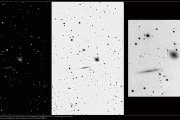Viewings: 5713

Astronomers authorized to state that the massive the star, which they of 2009 was repeatedly caught in the simulation of a supernova, still exploded truly (contrary to some doubt.)
Results of observations are of particular interest, as they provide important information about the throes of massive stars in the years immediately preceding the explosion.
The image SN 2009ip received September 24, 2012 Joseph Brimacombe.
Bright variable SN 2009ip was in the spiral galaxy NGC 7259, which is 67 million light years from Earth in the constellation of the southern Fish. Soon after the discovery of the explosion was recognized as non-fatal. The study of archival data showed further that the ancestor object repeatedly appeared on the image of the galaxy in the previous decade. The analysis of these images is allowed to determine that the star was blue and hot: it radiated about a million times more energy than the Sun, its mass exceeded solar 50-80 times and brightness varied strongly. Such objects known as the bright blue variables (AGP); such stars have almost exhausted the supply of hydrogen fuel, and for reasons that remain obscure, from time to time shed weight. The most famous example of the stars of this type - This Kiel from our Galaxy, exploded in 1843. Modern observations showed around her growing at a rate of about 600 km/s nebula of material which would be enough for ten Suns.
Flash AGP so bright that they can be seen in other galaxies. As the characteristics of the radiation of these objects mimic the parameters of a supernova, they are sometimes called pseudoscorpionida. SN 2009ip is one of these. Its first outbreak lasted 1-2 weeks, and, judging by the measurements of the spectrum, the material is rich in hydrogen, was thrown away with an approximate speed of 600 km/S. Through the year registered a second similar event, which also ended rather quickly. on July 24, 2012, after almost two years of relative calm, the astronomers noticed a third outbreak, but this time the situation has changed. Instead go out for a few days, the source remained bright for much longer. Moreover, after about two months in the spectrum of the object have been signs of extremely quick motion of the material: the rate reached 10 thousand km/S. This was the first hint that SN 2009ip exploded really.
But experts still confused that the brightness of the subject has not reached indicators common to supernova, remember the sponsors of research Nathan Smith and John Mauern of the University of Arizona (USA). Had to wait for the material ejected in 2012, will overtake that went into space in 2009 and 2010 with a much slower speed. It happened on September 22, and then the apparent brightness of an object has increased 100 times. To deny the supernova was already impossible. Brightness continued to increase during two weeks, after which she still slowly declining. Perhaps previously there were other flash - and on reaching then thrown material brightness for a short time will again grow.
"The fact that SN 2009ip exploded in phase AGP, extremely interesting, for it is not consistent with the standard theory of stellar evolution", - emphasizes Mr. Mauern. The latter says that shone with an initial mass of more than 30 solar rid of hydrogen shells mainly due to the strong wind and outbreaks, becoming saturated with helium star wolf - Rayet, and then become a supernova. However, scientists and earlier suspected that the stars can explode on stage AGP, without waiting for the stage star wolf - Rayet. This is important in the context of our Galaxy. SN 2009ip hints that stars like These Kiel capable of becoming a supernova at any time. And when This Kiel will explode and discarded material will meet with flown away before (and the star already got rid of more than ten solar masses), it will become so bright that, probably, it will be visible to the naked eye even in the light of day.
Relatively SN 2009ip still many unclear, because the question remains about the physical mechanism, which bears responsibility for recent supernova outbursts. In hypotheses is no shortage. For example, because the star-predecessor was very massive, its core could be a phenomenon pair-instability, when the interaction of gamma-radiation of high-energy atomic nuclei leads to the formation of electron-positron pairs, because of what the inside of a star is reduced thermal pressure. This is followed by gravitational compression of the stellar nucleus with a corresponding increase of temperature and pressure, which speeds up the nuclear reaction. The sudden release of nuclear energy can cause severe outbreak. The theory predicts that a massive star capable of several such episodes before exploding supernova.
According to another hypothesis, the activity SN 2009ip could be associated with advanced stages of burnout atomic nuclei. Once in the core of a massive star burned last hydrogen, it is helium, followed by carbon, neon, oxygen and silicon, which leads to the formation of the iron core. But the synthesis of iron is not a tool in the struggle with gravity, and there is a collapse. Phase of neon, oxygen and silicon last few years, and the beginning of each of them may be short, but powerful flash.
Ground observations do not allow us to confidently answer the question, which mechanism is involved in this case. But the situation can be made clear with the drop of the brightness of supernovae. Radioactive material synthesized in the explosion of the iron core is slowly degraded in the course of the year and produces light with a characteristic indicator of attenuation. So SN 2009ip will continue to attract the views of astronomers.
The research results presented at the meeting of the American astronomical society and accepted for publication by the journal Monthly Notices of the Royal Astronomical Society. Preprint available at the site arXiv .
Based on the materials Phys.Org.
















